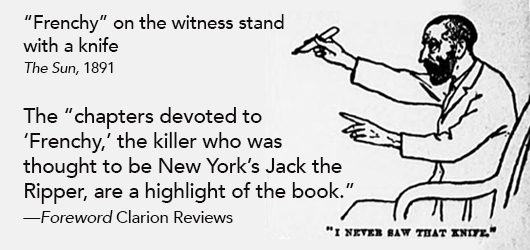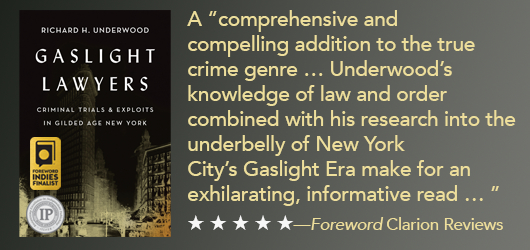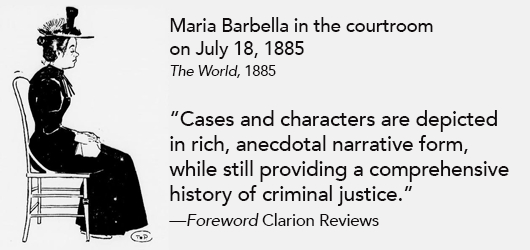Dark Side of the Gilded Age
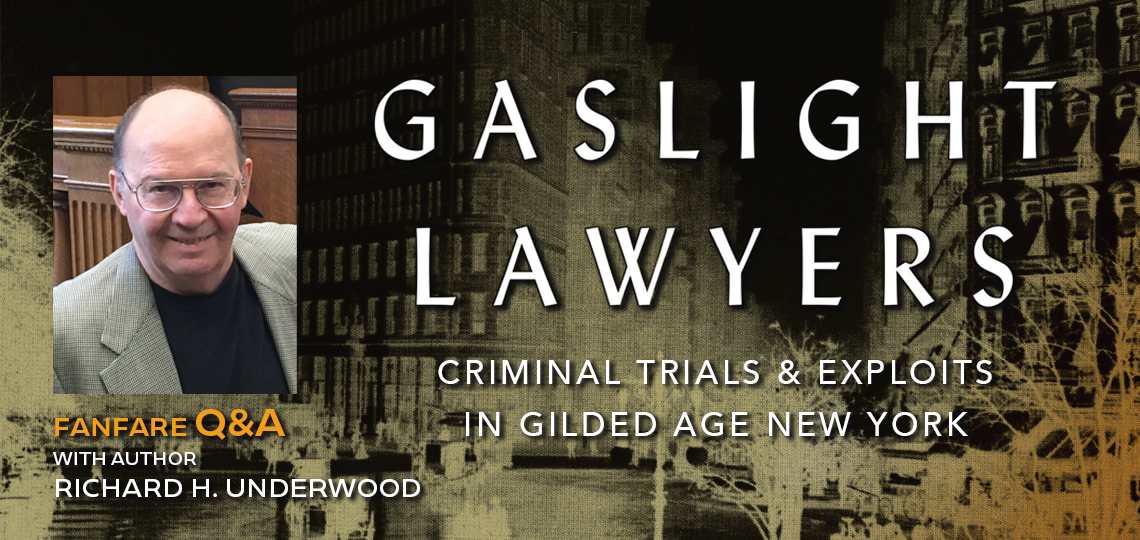
An interview with Richard H. Underwood, Author of Gaslight Lawyers: Criminal Trials and Exploits in Gilded Age New York
A lawyer himself, as well as a law professor and legal scholar, Richard Underwood has dedicated much of his life to researching both the brilliant tactics and not-so-flattering seediness and corruption of trial lawyers from the past 150 years. Of late, he has primarily focused his attention on the most notorious crimes of New York City’s Gilded Era—cases involving Hackensack Mad Monster, the Man-Killing Racetrack Girl, femme fatale Augusta Nack, and “Frenchy,” who was thought to be Jack the Ripper, for example—which lead to one of our favorite true-crime books, Gaslight Lawyers: Criminal Trials and Exploits in Gilded Age New York. The book earned a five star Clarion review, and spurred the following conversation between Richard and Danielle Ballantyne, one of Foreword’s top writers and reviewers.
Enjoy.
As a professor of law who has done extensive research into legal history, what drew you to the faces and cases of this period in American history in particular?
I have been a lawyer and law professor for almost fifty years, and I have written many articles and several books on the law of evidence and trial practice. I have a particular interest in legal ethics, and I wrote a book called Trial Ethics (Little, Brown and Co., 1988). Based on what you have seen recently in connection with the various Trump cases, you would suspect that a book about lawyers’ ethics would be a very short book. To steal a line from Simón Bolívar about fighting for democracy in South America, I feel like teaching legal ethics is like ploughing in the sea. However, my book is not short. It has gone through several editions under different titles and now totals around a thousand pages, counting all the supplements.
For many years, I collected cases and stories about lawyers’ tactics and what we might call lawyers’ and clients’ skullduggery. I have also been interested in legal history. Strangely enough, these interests have taken me in curious directions—in one book, I looked at the true crime stories behind nineteenth- and early-twentieth–century murder ballads. My wife, Virginia, was retiring from her career as a lawyer, and she had decided to start a small press she called Shadelandhouse Modern Press. Her first title as editor and publisher was my book CrimeSong: True Crime Stories from Southern Murder Ballads (2016). The Mountain Talk podcast covered CrimeSong and even included some musical performances. There is a link to this Mountain Talk episode on the Shadelandhouse Modern Press website.
Once I felt comfortable writing history, I decided to do research relating to some famous nineteenth-century trial lawyers, beginning with the notorious William “Big Bill” Howe and his partner Abraham “Little Abe” Hummel. They flourished during what Richard Rovere, a writer for The New Yorker, called the “Second Golden Age of the New York Bar.” Howe & Hummel were not only high-profile and ethically challenged criminal defense lawyers, but they also represented many celebrities, including P.T. Barnum, Edwin Booth, John Barrymore, Lillie Langtry, and Mark Twain. There are many entertaining stories about their exploits, and at one time, there was talk of a television series based on their practice. For a short time, Joseph Heller did some work on a screenplay about Howe & Hummel for playwright Harold Rome, but Heller dropped out of the project to write Catch-22!
My in-depth research into many Howe & Hummel cases, which involved hours reading old newspapers, trial transcripts, and memoirs, led to my second trade book. Virginia and I titled it Gaslight Lawyers: Criminal Trials & Exploits in Gilded Age New York (2017). The trial transcripts were saved from destruction by the folks at John Jay College of Criminal Justice, Lloyd Sealy Library, after shortsighted New York City authorities were cleaning house. I dedicated Gaslight Lawyers to the folks at the library.
Many people have commented lately that we seem to be living in a new Gilded Age, and the glamour of the original period seems to have caught the public’s attention. My book details the dark side of the Gilded Age, which has not gotten as much attention as the glamourous side has. There is certainly a dark side to America’s new Gilded Age and the lawyers who inhabit it, and I think this gives my book added relevance. Unfortunately, my title Gaslight Lawyers may not have been an ideal choice of words for our current times, because potential readers who are not history buffs might assume, wrongly, that the book has something to do with “gaslighting” in the modern, slang sense of the word. We used “gaslight” because the period was known for its gas streetlamps, before Edison’s electric lighting took over. The old gas light poles can still be found in parts of New York City. I hope this interview gets readers on the right track.
Anyway, I designed Gaslight Lawyers with each chapter or pair of chapters dedicated to a specific case so that the chapters can stand alone. Cases include the Nack-Thorn-Guldensuppe scattered body parts case, the “Frenchy/Old Shakespeare” case (aka, the New York “Jack the Ripper” case), and “Floradora Girl” Nan Patterson’s murder trials. But I also tried to write in a larger arc, showing how Howe & Hummel were succeeded by a new generation of criminal defense lawyers. That way I could write about the exploits of a number of other talented but lesser-known legal luminaries who practiced after Howe’s decline, and up to World War I. In the process of telling their stories, I also learned much, and I teach much about the early history of the forensic sciences, particularly forensic psychiatry.
While researching the cases within the book, which one most surprised you? Did you have any preexisting notions about the cases that were challenged or proven incorrect by your research?
Readers seem to like my account of the “Frenchy” case, a case which had been featured in Edwin Borchard’s classic Convicting the Innocent (1932) and which may (or may not) have been a case of wrongful conviction. But the case I found most interesting was the murder case (two trials) of Maria Barbella (aka, Maria Barbieri). Maria was a young Italian immigrant who slit the throat of her abusive lover. She was convicted in her first trial, which was far from a fair one, but she was acquitted after a second trial, during which her new lawyers presented a novel (and, at best, questionable) defense of “psychic epilepsy.” The defense expert was a “craniologist” whose testimony seemed to be based on a theory and “facts” originated and developed by her new lawyers.
In my opinion, the defense presented does not stand up to today’s science, although the expert witness later became celebrated as the chief anthropologist for the Smithsonian. Most of the material written about this case has tended to make Maria out as something of a feminist heroine, and I guess I was not so sympathetic. However, the case did coincide with my interest in the fate of female defendants and victims in the criminal justice system of the nineteenth century, which was a topic I dealt with in CrimeSong.
What is a case (or some cases) that didn’t quite make it into the book but that you would recommend for further reading on the subject?
There were many cases involving female victims and defendants that did not make it into the book. Many of the cases go back in time to so-called honor killings and strange mental state defenses advanced by both male and female defendants in the early and mid-nineteenth century. (I can think of some that inspired the stories of Poe and Twain.) These cases sparked my interest in nineteenth-century medicine and psychiatry, as well as in the gender inequality discussed in CrimeSong.
I also found that I was becoming immersed not only in nineteenth-century medicine but also in nineteenth- and early-twentieth–century literature. This store of research provides the basis for a really big work in progress, with lots of digressions and stories within stories, which I have not yet published—all dedicated to real-life characters who played important roles in the history of forensic psychiatry. Hopefully you will forgive me for not discussing this unpublished work in detail at this time. I will say that these stories are well-grounded in fact, yet they will seem fantastic, often creepy, and at times wonderfully amusing! Netflix or PBS, here I come?
True crime and crime dramas are only growing in popularity, shared through every vehicle from plays to podcasts, but they are often sensationalized (if not fully fictionalized in places) for the sake of drawing in viewers. How do you feel about the rise of true crime media? What do you think is working or not working within the genre?
As you can see, my forays into the true crime genre may seem a bit academic to some people, but I think my stories are much more interesting and entertaining than many of the police procedurals that fill the big and small screens today. As Twain (was it really Twain?) said (I paraphrase), “Truth is stranger than fiction, because fiction has to be plausible, while the truth does not.” I approach the subject of true crime from the perspectives of history, literature, sociology, gender studies, medicine, and psychiatry, while exploiting my expertise in trial law and advocacy. I think that these touches are lacking in much of today’s true crime.
While the cases in your book certainly captured the public’s attention and dominated headlines in their time, no one could have imagined the media circuses and courtroom spectacles of trials—and even investigations—that we have today. In what ways do you feel this increased interest and access has helped and/or hurt the criminal justice system? What do you feel modern-day judges, lawyers, and others working within the legal system can learn from studying America’s criminal justice history? What lessons would you hope they draw?
I have mixed feelings about this. There are some people who seem to think that discussing crime romanticizes it and even encourages criminal behavior. I got some of that backlash when CrimeSong was published. I think that point of view is rather silly and a bit posturing. To make another point, I would say that the public has come to expect too much when it comes to crime solving—this is the so-called CSI effect. People have come to think that, in light of technological wonders featured in the television and cable series, “justice” should be quickly and easily served up. Viewers—and actual jurors—can be too quickly critical of the folks in the trenches. Modern forensics have helped, but crime-solving is still not easy.
And there is also a dark side to all this. Sometimes it is hard to tell the good guys from the bad. In the course of my academic career, I have written a lot about false convictions and bad science. I think that it is important to remember that the system cannot guarantee justice, but it can and must provide an opportunity for justice, and it must not be allowed to do injustice.
In that regard, it is important to also keep in mind that increased interest and education in, and access to facts about, our criminal justice system has a positive side. As Mark Twain and Charles Dudley Warner said in their book The Gilded Age: A Tale of Today (1873), “No country can be well governed unless its citizens as a body keep religiously before their minds that they are the guardians of the law, and that the law officers are only the machinery for its execution, nothing more.”
Lastly, are there any other cases or subjects calling to you for future authorial endeavors?
As I have noted, I am finishing up a big manuscript (but I do worry about what the Greeks said: mega biblion, mega kakon). I also have a short study of an old Connecticut murder case in the editorial process, and I am working on a gothic novel (or is it history?—I may keep that a little vague) set in antebellum Lexington, Kentucky. The novel features a ghoulish antihero whose interests are law, medicine, and general devilry. He’s nothing like me, of course. Wish me luck?
Gaslight Lawyers
Criminal Trials and Exploits in Gilded Age New York
Richard H. Underwood
Shadelandhouse Modern Press (Sep 19, 2017)
Clarion Rating: 5 out of 5
The true allure of the book is in its artfully chosen details, taken from sources ranging from court transcripts to personal memoirs.
Richard H. Underwood’s Gaslight Lawyers is an intriguing collection of stories profiling some of New York City’s most influential lawyers of the late nineteenth and early twentieth centuries, as well as their law enforcement counterparts and the diverse set of cases they handled.
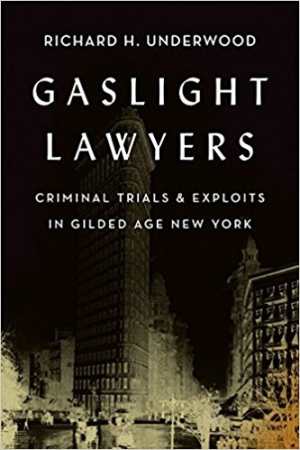
In a time when criminal lawyers were elevated to celebrity status, cases were often defined—and their outcomes determined—by the characters at trial, rather than by the nature of the crimes themselves. The time period often referred to as the Gaslight Era was marked by an often corrupt criminal justice system, “when the field of scientific, forensic evidence was only beginning to emerge and when guilt or innocence usually turned on eyewitnesses in testimony.” Throughout the book, this corruption is made abundantly clear.
Gaslight Lawyers is divided into ten chapters, each of which covers either a lawyer’s career or a specific case. Three chapters are devoted to notorious defense attorney William “Big Bill” Howe, the man behind the Hackensack Mad Monster, the Man-Killing Racetrack Girl, and the case of femme fatale Augusta Nack. Prosecutor William “The Reformer” Travers Jerome is the focus of the final chapter, which details his career as a DA known for convicting corrupt attorneys.
Within the book, these attorneys are revered as often as they’re criticized, and despite occasional editorializing, stories are kept objective and in context. The book’s greatest service to the field of true crime is its focus on cases in the grand scheme of criminal justice. It still takes into account the often nefarious ethics of the era, when shady tactics were the norm and smooth-talking defense attorneys swayed entire juries.
The two chapters devoted to “Frenchy,” the killer who was thought to be New York’s Jack the Ripper, are a highlight of the book. The pages are filled with vivid yet conscientious descriptions of the crime scene, with lines like “a gash extended from the base of the spine, carried upward across her abdomen and reaching a point halfway up her right side.” These chapters are flooded with evidence of how much input came from those inside the criminal justice field and also from the media, who sensationalized an already considerable spree of murders.
The book keeps a riveting pace throughout, maintaining interest even in dense, history-packed sections, thanks to accessible language and interpretation. Cases and characters are depicted in rich, anecdotal narrative form, while still providing a comprehensive history of criminal justice.
The true allure of the book is in its artfully chosen details. Combining research ranging from court transcripts to personal memoirs, it reconstructs scenes with the kind of particulars that usually come from firsthand experiences. Fascination with the law and with criminal proceedings imbues the pages, imparting a delightful sense of suspense, even though the book often deals in cases with known outcomes.
Gaslight Lawyers is a comprehensive and compelling addition to the true crime genre, offering a template for balancing characterization with content. Richard H. Underwood’s knowledge of law and order combined with his research into the underbelly of New York City’s Gaslight Era make for an exhilarating, informative read.
Reviewed by Lillian Brown
October 16, 2017
Danielle Ballantyne

